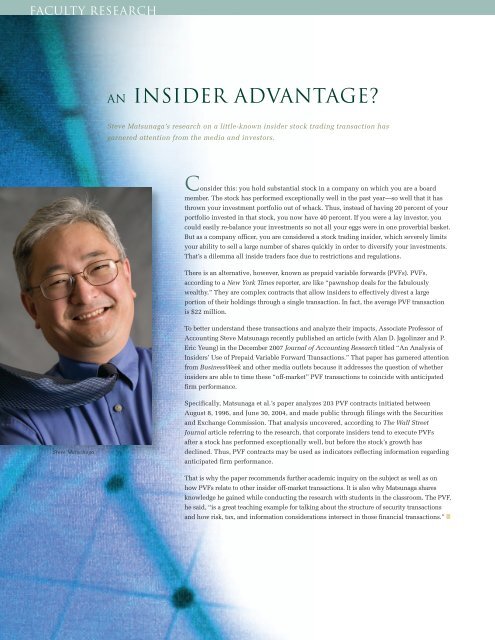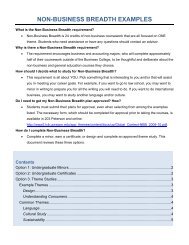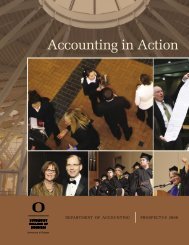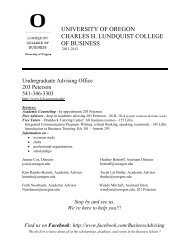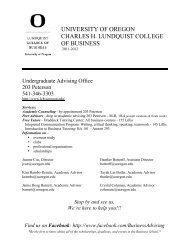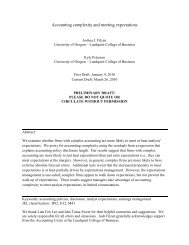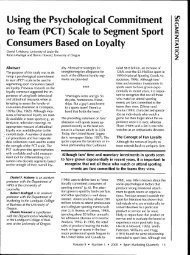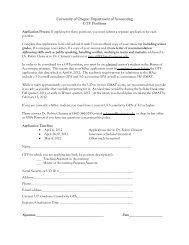The Business of Writing - Lundquist College of Business - University ...
The Business of Writing - Lundquist College of Business - University ...
The Business of Writing - Lundquist College of Business - University ...
- TAGS
- lundquist
- lcb.uoregon.edu
You also want an ePaper? Increase the reach of your titles
YUMPU automatically turns print PDFs into web optimized ePapers that Google loves.
10<br />
faculty research<br />
Steve Matsunaga<br />
aN INSIdEr advaNtagE?<br />
Steve Matsunaga’s research on a little-known insider stock trading transaction has<br />
garnered attention from the media and investors.<br />
consider this: you hold substantial stock in a company on which you are a board<br />
member. <strong>The</strong> stock has performed exceptionally well in the past year—so well that it has<br />
thrown your investment portfolio out <strong>of</strong> whack. Thus, instead <strong>of</strong> having 20 percent <strong>of</strong> your<br />
portfolio invested in that stock, you now have 40 percent. If you were a lay investor, you<br />
could easily re-balance your investments so not all your eggs were in one proverbial basket.<br />
But as a company <strong>of</strong>ficer, you are considered a stock trading insider, which severely limits<br />
your ability to sell a large number <strong>of</strong> shares quickly in order to diversify your investments.<br />
That’s a dilemma all inside traders face due to restrictions and regulations.<br />
<strong>The</strong>re is an alternative, however, known as prepaid variable forwards (PVFs). PVFs,<br />
according to a New York Times reporter, are like “pawnshop deals for the fabulously<br />
wealthy.” <strong>The</strong>y are complex contracts that allow insiders to effectively divest a large<br />
portion <strong>of</strong> their holdings through a single transaction. In fact, the average PVF transaction<br />
is $22 million.<br />
To better understand these transactions and analyze their impacts, Associate Pr<strong>of</strong>essor <strong>of</strong><br />
Accounting Steve Matsunaga recently published an article (with Alan D. Jagolinzer and P.<br />
Eric Yeung) in the December 2007 Journal <strong>of</strong> Accounting Research titled “An Analysis <strong>of</strong><br />
Insiders’ Use <strong>of</strong> Prepaid Variable Forward Transactions.” That paper has garnered attention<br />
from <strong>Business</strong>Week and other media outlets because it addresses the question <strong>of</strong> whether<br />
insiders are able to time these “<strong>of</strong>f-market” PVF transactions to coincide with anticipated<br />
firm performance.<br />
Specifically, Matsunaga et al.’s paper analyzes 203 PVF contracts initiated between<br />
August 8, 1996, and June 30, 2004, and made public through filings with the Securities<br />
and Exchange Commission. That analysis uncovered, according to <strong>The</strong> Wall Street<br />
Journal article referring to the research, that corporate insiders tend to execute PVFs<br />
after a stock has performed exceptionally well, but before the stock’s growth has<br />
declined. Thus, PVF contracts may be used as indicators reflecting information regarding<br />
anticipated firm performance.<br />
That is why the paper recommends further academic inquiry on the subject as well as on<br />
how PVFs relate to other insider <strong>of</strong>f-market transactions. It is also why Matsunaga shares<br />
knowledge he gained while conducting the research with students in the classroom. <strong>The</strong> PVF,<br />
he said, “is a great teaching example for talking about the structure <strong>of</strong> security transactions<br />
and how risk, tax, and information considerations intersect in those financial transactions.”


